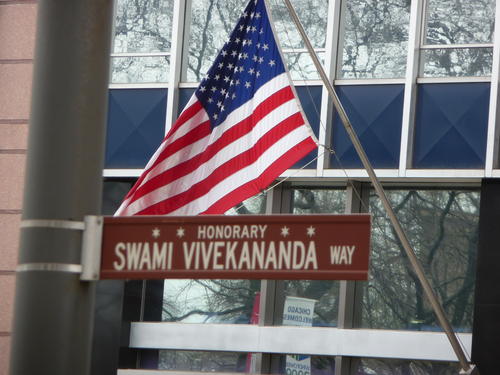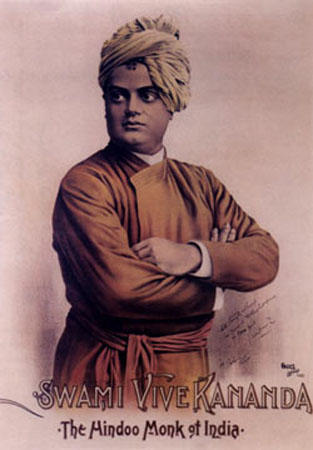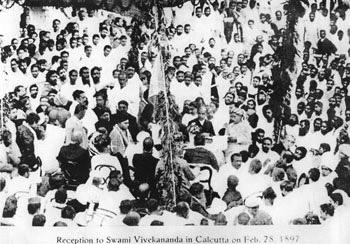Rethinking Vivekananda through Space and Territorialised Spirituality, c. 1880-1920
Honorary Swami Vivekananda Way sign
Image Credit: John Kannenberg / Flickr
Swami Vive Kananda, the Hindoo Monk of India
Reception to Swami Vivekananda in Calcutta, 25 Feb 1982
Let’s say that you are an art enthusiast visiting Chicago. One of the obvious places to tour would be the Art Institute. You walk along S Michigan Avenue towards the museum, and as you approach you look up at the street sign to check your location. What you will see, perhaps to your surprise, is the brown plaque ‘Honorary Swami Vivekananda Way’ marking your arrival at the destination. Who was Vivekananda, and why is his name associated with Chicago’s one of the biggest sites of attraction?
Swami Vivekananda (1863-1902) was a Bengali monk and a renowned proponent of Hinduism. He was a quintessential nineteenth century figure who was highly mobile and widely connected to ideas and people beyond his locality. From various pockets in the Indian subcontinent to Hong Kong, Vancouver, Chicago, Paris, and Egypt, Vivekananda spent most of his life traveling and propagating Hinduism as the religion of ‘tolerance and universal acceptance’.[1]
In 1893, he attended the Parliament of the World’s Religions held in Chicago where the Art Institute stands today. The brown plaque (picture above) was installed on 11 September 1995 to commemorate his speech which opened with the line ‘Sisters and Brothers of America’ and closed with a call against fanaticism, persecutions, and ‘all uncharitable feelings between persons wending their way to the same goal’.[2] His activism for universal values continued beyond his performance at the international event. In 1894, he founded the Vedanta Society in New York to teach yoga and Hinduism to bourgeois audience. He was the star of numerous private salons in Boston, New York, Paris and London creating public spheres mostly composed of women. In India, he created a new religious order of Hindu monks called the Ramakrishna Math and Mission as a way of serving the public, or seva. To this day, the various branches of the Math and Mission in India provide flood relief, food to the poor and educate the youth, while the branches outside of India offer regular classes and retreats.[3]
While his legacy in the United States of America and in the global branches of his religious organization presents a saintly picture of him, he also emerges in more exclusionary platforms. Under the governments of Narendra Modi in India and Donald Trump in the USA, Vivekananda has resurfaced as a pioneer of ‘Hindu India’.[4] He is regularly evoked in political campaigns and student protests espousing a parochial vision of India.[5] Consequently, his ideas of religious tolerance is incorporated into the reaffirmation of Hindu nationalism.[6]
Like his omnipresent spectre that occupies a wide political spectrum, Vivekananda is depicted in polarizing narratives in existing scholarship. Some historians have attempted to ‘rescue Vivekananda’s idealism from political distortions’.[7] Others have moulded him into a paterfamilias of Hindu nationalism.[8] This binary in both popular memory and existing scholarship reveals the gap between discomfort with and willingness to politicising the spiritual icon on the one hand, and the dominant narrative of nationalism that steers our interpretation of historical figures. In particular, privileging the teleology of the nation-state in historical writing, which the transnational turn has ironically furthered, erases the various social, cultural, and political dynamics—distinct from connections—that shaped the figure and his ideas. After all, like other campaigners of his time and before, Vivekannada’s messages varied depending on the setting and the audience, and he evolved throughout his life.
The monograph project, Rethinking Vivekananda through Space and Territorialised Spirituality c.1880-1920 addresses this tension that lies at the crux of Vivekananda’s legacy. Rather than placing his ideas into the conceptual binary of Hindu nationalism and universalism, it explores the making of the figure and his thoughts, by reading spaces with his texts. It examines the places he occupied—the princely states in colonial India, the international stage of the Parliament of World’s Religions (Chicago, 1893), and bourgeoise salons in the USA and Europe—and the spaces he produced—the Vedanta Society in New York, the Ramakrishna Math and Mission in Bengal and its branches scattered across the Indian subcontinent. In doing so, it takes global history as a method and sheds light on both the figure and the entangled history of the period.
Expanding our horizon beyond Vivekananda to his surroundings also leads us to widen our understanding of internationalism. If existing scholarship on internationalism has predominantly focused on state-sponsored conferences and political actors, the book introduces new sites and creators of global publics—everyday places, small princely states, women’s clubs, unexpected encounters, collaborations, and betrayals. How did Vivekananda’s concept of spirituality challenge social norms and create counterpublics in the USA and India? Who participated in the production of spiritual global publics and why? In probing these questions, the book speaks to a wide range of readers who are interested in new histories of internationalism and the global making of spirituality.
[1] Swami Vivekananda, Addresses at the Chicago Parliament of Religions (Calcutta: Ramakrishna Mission, 1907), 2.
[2] Id., 4.
[3] Gwilym Beckerlegge, Swami Vivekananda’s Legacy of Service (New Delhi; Oxford: Oxford University Press, 2006).
[4] ‘Namaste Trump’ was an event held on 24 February 2020 at the world’s largest cricket stadium, Sardar Patel Gujarat Stadium in Ahmedabad, to welcome the Trump family’s visit to India. At this event, Trump not only mentioned Vivekananda but also praised Modi’s leadership for being ‘very tough’ amongst other things. For more, see https://www.theguardian.com/world/2020/feb/24/namaste-donald-trump-india-welcomes-us-president-narendra-modi-rally
[5] Akhil Bharatiya Vidyarthi Parishad, for example, is a student organisation affiliated with the right-wing political party RSS that uses Vivekananda in its various rallies.
[6] For more on masculinity and Hindu nationalism, see Mrinalini Sinha, Colonial Masculinity: The “Manly Englishman” and the “Effeminate Bengali” in the Late Nineteenth Century (Manchester: Manchester University Press, 1995).
[7] William Radice and Tapan Raychaudhuri (eds.) Swami Vivekananda and the Modernization of Hinduism (Delhi: Oxford University Press, 1998).
[8] Jyotirmaya Sharma, A Restatement of Religion: Swami Vivekananda and the Making of Hindu Nationalism (New Haven; London: Yale University Press, 2013).
Related text:
Sophie-Jung H. Kim, ‘An International Event and Its Multiple Global Publics: The Parliament of the World’s Religions (Chicago, 1893), and Vivekananda’, in Global Publics: Their Power and Their Limits, 1870-1990 eds. Valeska Huber & Jürgen Osterhammel (Oxford: Oxford University Press, 2020).
Keywords
- Global Publics and Counterpublics
- New Histories of Internationalism
- Spaces and Places of Communication



